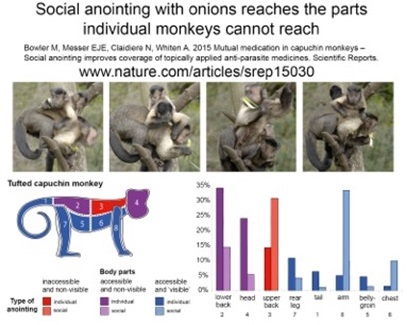Guest written by Dr Emily Messer
Monkey medicine, (https://www.youtube.com/watch?v=I5TDlG441gA) a behaviour where our capuchin monkeys (like their wild counterparts) will pick up and rub pungent materials like onions into their fur as a king of ‘monkey self-medication’ has been revisited recently. Funded by the Wellcome Trust, researchers from the University of St Andrews, Dr’s Mark Bowler, Emily Messer, Nicolas Claidière and Professor Andrew Whiten have recently published a new paper (https://www.youtube.com/watch?v=I5TDlG441gA) describing the function of the behaviour and explaining why the monkeys do this socially.
Dr Mark Bowler, one of the researchers on the project has created the following new video clip (https://www.youtube.com/watch?v=EeRsO2Dz8ZU) which follows on the original monkey medicine video to showcase the main results of the study. The researchers discovered that when socially anointing with group mates, the capuchin monkeys were focusing on inaccessible areas of their bodies, such as their upper back, so together they achieve whole body coverage. As a result, if you’re a capuchin monkey, a raw onion is just the thing to rub into your fur, and if there are bits of you that you can’t reach, then one of your group mates is around to help you reach those hard-to-reach areas. And just as when some children in a class have lice it becomes important to treat the whole class to avoid re-infection, so, the research team concluded, the social fur rubbing of the capuchins results in the whole group having their entire bodies protected.
Link: to video about the experiment: https://www.youtube.com/watch?v=EeRsO2Dz8ZU&feature=youtu.be
Link to paper itself: Bowler, M., Messer, E. J. E., Claidière, N., Whiten, A. (2015) Mutual medication in capuchin monkeys – Social anointing improves coverage of topically applied anti-parasite medicines. Scientific Reports 5 http://www.nature.com/articles/srep15030
